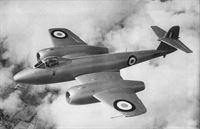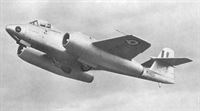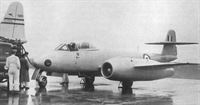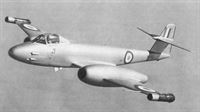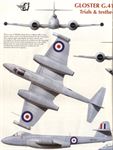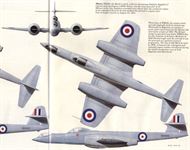Фотографии
-
Регистрационный номер: G-AGOS, VZ728 Reid & Sigrist Desford G-AGOS after modification for prone-pilot trials, with lengthened nose and in military markings as VZ728. In this form it was known as the R.S.4 Bobsleigh, for obvious reasons.
Самолёты на фотографии: Reid and Sigrist R.S.3 Desford / R.S.4 Bobsleigh - Великобритания - 1945
-
Регистрационный номер: WA982 [4] WA982, Rolls-Royce’s Meteor Mk 8, here shown when used as the flying testbed for the company’s Soar lightweight expendable turbojet, which was envisaged as the powerplant for projects on the drawing boards of several aircraft manufacturers in the 1950s. Being from an early production batch, the aircraft retained the smaller-diameter intakes for its standard Derwent 8 engines.
Самолёты на фотографии: Gloster Meteor F.Mk.8 / FR.Mk.9 - Великобритания - 1948
-
Регистрационный номер: WA820 [7] WA820, the Mark 8 which, with two Armstrong-Siddeley Sapphire 2 engines each developing 7,600lb thrust, was the most powerful of all Meteors to fly. One Sapphire provided more thrust than the combined output of two standard Derwent 8s and enabled the aircraft to capture four time-to-height records on August 31, 1951.
Самолёты на фотографии: Gloster Meteor F.Mk.8 / FR.Mk.9 - Великобритания - 1948
-
Регистрационный номер: WK935 [2] WK935, the unique trials aircraft originally built by Armstrong-Whitworth at Baginton to evaluate a prone-pilot requirement for the Bristol 185 interceptor project of 1952. The Bristol design evaporated long before WK935 flew but the Institute of Aviation Medicine at RAE Farnborough used the aircraft to test the principle as a general research programme. The last of 429 Mark 8s built by AWA, it featured the redesigned and enlarged engine intakes introduced during the mark’s production runs at both Baginton and Hucclecote.
Самолёты на фотографии: Gloster Meteor F.Mk.8 / FR.Mk.9 - Великобритания - 1948
-
Регистрационный номер: WA820 [7] Meteor Mark 8 WA820 shows off its massive engine nacelles, housing Armstrong Siddeley Sa2 Sapphires.
Самолёты на фотографии: Gloster Meteor F.Mk.8 / FR.Mk.9 - Великобритания - 1948
-
Регистрационный номер: WA820 [7] WA820 makes a smart take-off during the 1950 SBAC show, after which it returned to testing.
Самолёты на фотографии: Gloster Meteor F.Mk.8 / FR.Mk.9 - Великобритания - 1948
-
Регистрационный номер: WA820 [7] The Sapphire Meteor at London Airport for its “off the Secret List” demonstration on August 31, 1950.
Самолёты на фотографии: Gloster Meteor F.Mk.8 / FR.Mk.9 - Великобритания - 1948
-
Регистрационный номер: WA820 [7] The large tail bumper is evident here.
Самолёты на фотографии: Gloster Meteor F.Mk.8 / FR.Mk.9 - Великобритания - 1948
-
Регистрационный номер: WK935 [2] Prone-pilot Meteor WK935 airborne at Coventry, with its new and peculiar proboscis plain to see.
Самолёты на фотографии: Gloster Meteor F.Mk.8 / FR.Mk.9 - Великобритания - 1948
-
Регистрационный номер: WA820 [7] Study of the Sapphire Meteor during its appearance at the 1950 SBAC Show at Farnborough. It is seen inverted. The airframe had to be specially strengthened to cope with the extra power, and the wing mainspars had to be reshaped to accommodate the engines’ physical bulk.
Самолёты на фотографии: Gloster Meteor F.Mk.8 / FR.Mk.9 - Великобритания - 1948
-
Регистрационный номер: WA982 [4] Soar Meteor WA982 touches down during the 1954 SBAC Show; the only occasion when it actually had a Soar in each wingtip nacelle.
Самолёты на фотографии: Gloster Meteor F.Mk.8 / FR.Mk.9 - Великобритания - 1948
-
Регистрационный номер: WA982 [4] The Soar Meteor continued its test work until March 1956, when it reverted to standard.
Самолёты на фотографии: Gloster Meteor F.Mk.8 / FR.Mk.9 - Великобритания - 1948
-
Регистрационный номер: WA820 [7] Study of the Sapphire Meteor during its appearance at the 1950 SBAC Show at Farnborough. The Hawker Siddeley logo on the nose is well shown.
Самолёты на фотографии: Gloster Meteor F.Mk.8 / FR.Mk.9 - Великобритания - 1948
-
Регистрационный номер: WA982 [4] Soar Meteor WA982 shortly before its 1954 Farnborough appearance.
Самолёты на фотографии: Gloster Meteor F.Mk.8 / FR.Mk.9 - Великобритания - 1948
-
Three-view of WA982, Rolls-Royce’s Meteor Mk 8, here shown when used as the flying testbed for the company’s Soar lightweight expendable turbojet, which was envisaged as the powerplant for projects on the drawing boards of several aircraft manufacturers in the 1950s. Being from an early production batch, the aircraft retained the smaller-diameter intakes for its standard Derwent 8 engines.
Самолёты на фотографии: Gloster Meteor F.Mk.8 / FR.Mk.9 - Великобритания - 1948
-
Three-view of WK935, the unique trials aircraft originally built by Armstrong-Whitworth at Baginton to evaluate a prone-pilot requirement for the Bristol 185 interceptor project of 1952. The Bristol design evaporated long before WK935 flew but the Institute of Aviation Medicine at RAE Farnborough used the aircraft to test the principle as a general research programme. The last of 429 Mark 8s built by AWA, it featured the redesigned and enlarged engine intakes introduced during the mark’s production runs at both Baginton and Hucclecote.
Самолёты на фотографии: Gloster Meteor F.Mk.8 / FR.Mk.9 - Великобритания - 1948
Статьи
- -
- 1996 UK Aircraft Collections and Museums Guide (1)
- Airshows & events
- Personal album. Military
- A.Lumsden - First solo
- B.Jones - Trials and Testbed Meteors (4)
- B.Ogden - Turkish delights
- D.Webb - Tested & failed (6)
- G.Copeman - A backward glance
- H.Amtmann - River monster
- J.King - Wanaka warbirds
- J.Miller - Ethiopian treasure
- M.Oakey - Vintage news
- T.Hooton - Nocturnal navigator (6)




